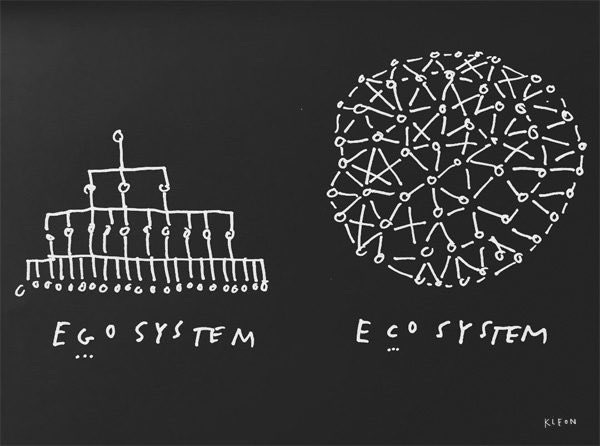Framer is a newsletter that offers re-frames so that we can imagine other realities.
My friend’s dad once asked her: “What’s the difference between humans and other animals?”
Even as a little girl, she knew: “humans tell stories.”
Communication is how we collaborate and make meaning, but also how we create enemies and make drama.
The Tower of Babylon myth is my favorite little drama. According to this myth, it used to be that everyone spoke the same language and worked together to build a structure that could reach God. God, seeing that humans were getting too close and amassing too much power, made it so that humans could no longer speak the same language. In other words, God decided to introduce some chaos to give us a different way to pass the time. Good thing, too. What would have happened otherwise? We’d reach the top and find…..? Imagine a bunch of listless people with no higher purpose? Danger zone.
Instead, we’re here, trying to figure out how to exist together, amidst all these different languages and stories. The Internet age is the Tower of Babylon myth taken to its logical conclusion. Not only do people speak different languages, but they can find other people who speak their very specific dialect, based on their identities and values, and make little wars with other people who diverge from their norm. It can make communication feel exhausting.
I like the way science fiction writer Nnedi Okorafor described why we’re having such a hard time hearing one another in a recent Atmos interview:
“I agree that people are really bad at listening. And in some regards, I understand why they’re bad at listening because they’ve had to hear a lot. And I also think that there’s a lot of hurt and a lot of fear. And then on top of all of that, there’s this structure that we already live in, the systemic stuff that’s already there, that’s just messing with the possibility of people being able to start to listen because of the fear and the hurt. That’s the cycle I think we are stuck in…and you never know, the next thing you say, you’ll just get canceled.”
We need a respite, a way to listen that doesn’t feel scary.
Perhaps, as a reaction to poor human-on-human communication, I’m seeing more examples of humans trying to listen to plants and animals.
Sound artists like Crystal Quartez and Mileece are making ambient music with plants, by attaching electrodes to catch the bio-electric emissions coming off of plants.
What is the point of listening to a plant?
There is a beauty in discovery, without the pressure of needing to relate. When we interact with plants, we don’t need to be understood at all. The plants don’t have the capacity to strategize, to have a motive. This makes the interaction feel pure.
It’s nice to experience something digital that also feels pure or playful, given that we live with so many digital products that are constantly trying to persuade or surveil. Discovery in this way feels spiritual — a way to interact with something that doesn’t make sense but feels good. You don’t need words to feel connected to other living beings.
Listening to plants goes beyond the musical. There is a whole field called soil ecoacoustics, in which biologists listen to bacteria, fungi, mites, and a whole bunch of other living beings to understand how “they eat or hunt, how they slither past each other unnoticed, or drum, tap and sing to get one another’s attention.”

Scientists are finding that intensely farmed lands are much quieter, signaling a lack of biodiversity. The louder our soil is, the more alive, the better.
Sound exposes life.
Britt Selvitelle and Aza Raskin started the Earth Species project to translate animal sounds into something that we can understand.
They’re generating shapes that represent entire languages, which can be used to translate languages without dictionaries and without examples of translation.
Will anything change once we can understand animals in this way?
They’re hoping that if humans can relate to other species, we’ll care more about them. Communication is how we make meaning. If we can understand the stories animals are telling one another, will they will seem more alive, more worth saving?
The Tower of Babylon myth is extended to the animal kingdom. If we get good at listening, and translation, do we climb the Tower and get closer to “God”? Do we save ourselves from climate change?

What does our relationship with “Nature” say about our relationship with one another, right now?
In “The Erotics of Rot,” Elvia Wilk points out that the way we think about nature tends to be binary, the same way we struggle with love.
“Nature is benevolent, or nature is the enemy.”
“Being in love is a sticky place. One wants to stay and one wants to escape. One wants to open and one wants to close.”
This binary way of thinking is a vestige of purity culture; a focus on protection and defense. In the modern Western world, we don’t see that many examples of healthy interdependent relationships.
But there are examples elsewhere. Suzanne Simard is (in)famous for discovering that trees communicate with one another via pheromones; that trees from different species protect one another and share resources. In all of her research, she took extra care to anthropomorphize the trees, even though this type of language is not accepted in serious academic papers. She wanted to pay respect to indigenous cultures that have considered trees this way for a long time. She also wanted to make the connection for readers that trees form relationships, just like we do.
We don’t yet fully understand the extent of tree relationships. I’m going to assume they’re a lot less complicated than human relationships, though. Do trees have drama? Do they make up stories the way we do?
When meaning-making feels too exhausting, it’s nice to go back to the physical, the sensuous — it’s a relief how straightforward those desires can be.
Just like animals send signals through sound vibration because it’s most efficient, sometimes it’s just simpler to give your friend a hug. You don’t need to know the right thing to say when you’re just there.
I’ll leave you with this little tidbit from The Spell of the Sensuous: Perception and Language in a More-Than-Human World, that I picked up from my friend Sara’s excellent newsletter, Tiny Revolutions:
“We must renew our acquaintance with the sensuous world in which our techniques and technologies are all rooted.”
“Direct sensuous reality, in all its more-than-human mystery, remains the sole solid touchstone for an experiential world now inundated with electronically-generated vistas and engineered pleasures.”
Humans are animals, after all.







“You don’t need words to feel connected to other living beings.” A 1,000 times yes! Thank you, Agnes. ❤️